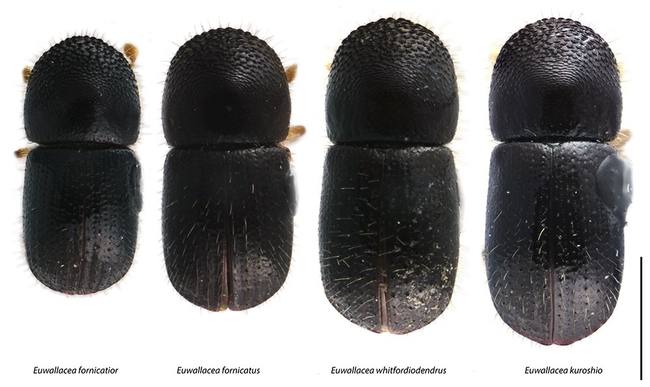So Many Shot Hole Borers: New Research Charts Four Nearly Identical Species
by Jiri Hulcr, Ph.D., and Jackson Landers
When an insect spends most of its life in total darkness, it doesn't much matter what color it is. So, it comes as no surprise that so many species of bark and ambrosia beetles maintain the same brown hue as they slowly tunnel through wood and feed on a fungus that they carry with them into their trees. This similarity of appearance has been taken to an extreme in what has turned out to be a cryptic species complex. What was once referred to as the “tea shot hole borer” is actually four distinct species who all look almost exactly the same.
The tea shot hole borer first attracted notice from North American entomologists when it appeared in Florida in 2012, appearing harmless. But the beetles were first described as an economically significant pest in Sri Lanka in 1968. In 2009, the beetles were found eating through avocado and street trees in Israel. Then, in 2012 in California, with a bang, avocado trees were being attacked and killed. Given the value of global avocado crops and tea plants, entomologists had to start taking a closer look at these beetles.
Many taxonomists eventually came around to the idea that they were looking at three identical species rather than one: the tea shot hole borer (from southern Southeast Asia), the Kuroshio shot hole borer (originating in the Pacific Islands), and the polyphagous shot hole borer (presumed native to northern Southeast Asia). A 2017 paper authored by Richard Stouthamer and his team from the University of California, Riverside, first designated those three clades and established common names for them.
from entomologytoday.org
https://entomologytoday.org/2019/01/07/so-many-shot-hole-borers-new-research-charts-four-nearly-identical-species/
The four newly delineated species of the Euwallacea fornicatus species complex are, from left to right, E. fornicatior, E. fornicatus, E. whitfordiodendrus, and E. kuroshio. The wood-boring beetles known as various kinds of “shot hole borers” are so similar in morphological characteristics while also variable in body dimensions that their appearance can't be reliably used for differentiating specimens. (The four shown here vary in size but some of their cousins within each species can all range from 1.8 to 2.9 millimeters long.) New research has used molecular genetic techniques to identify the different species within the complex. (Photo credit: Demian Gomez)
And read more from the folks at UC:
https://ucanr.edu/sites/eskalenlab/files/296160.pdf
Attached Images:
